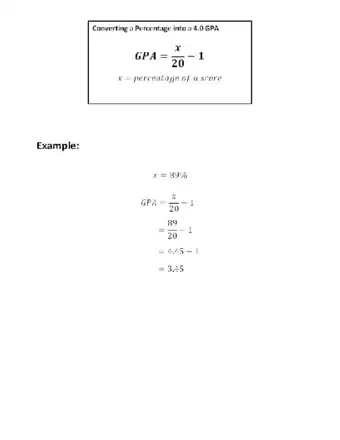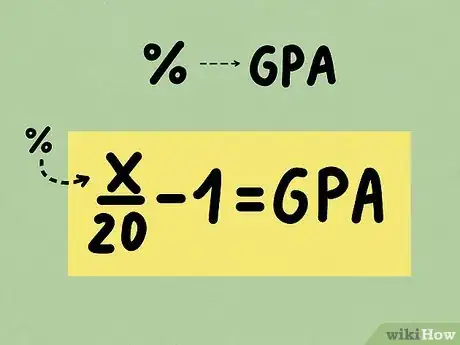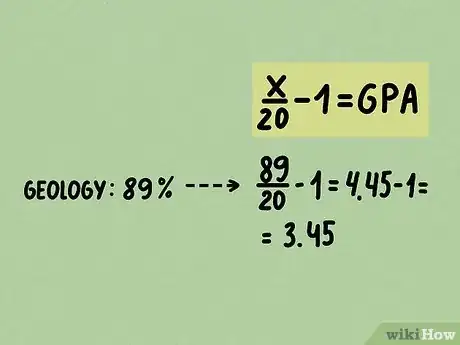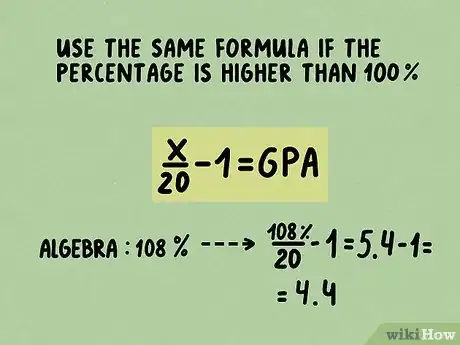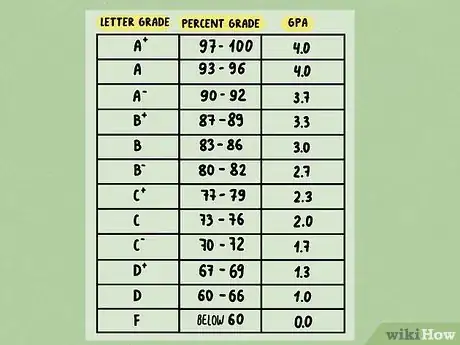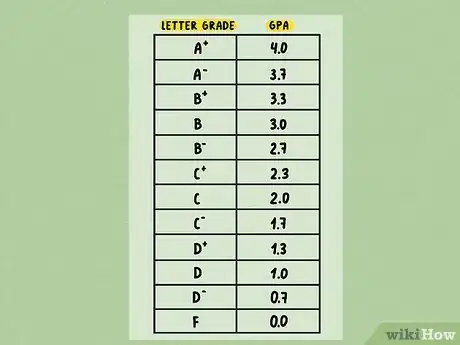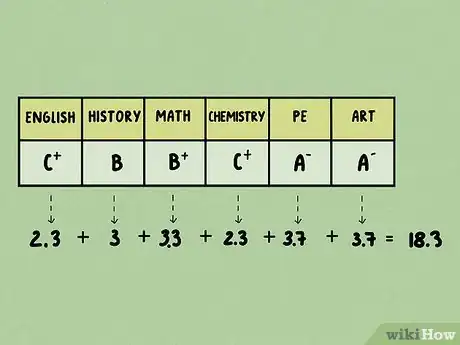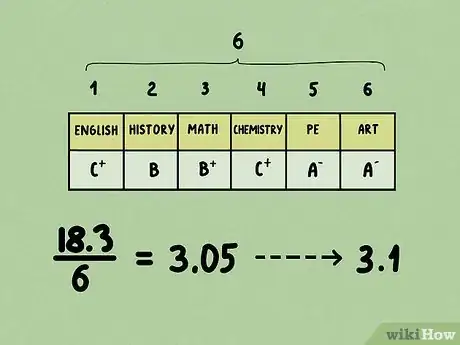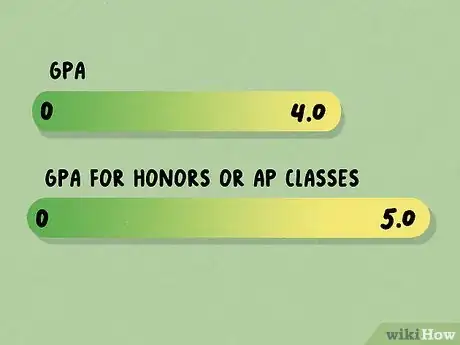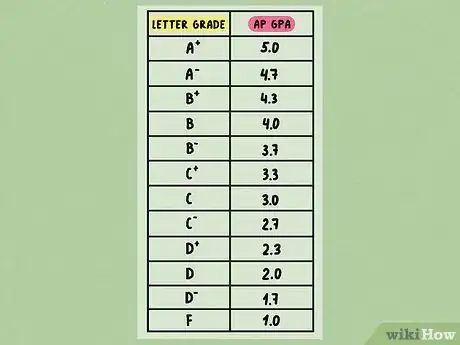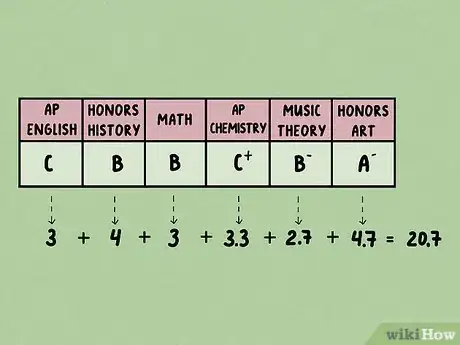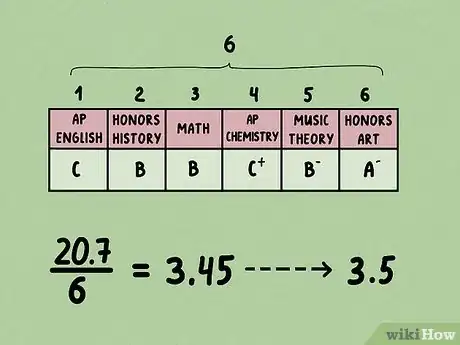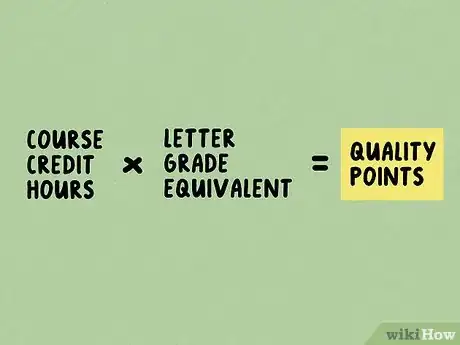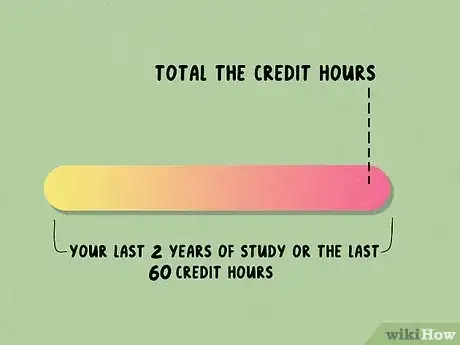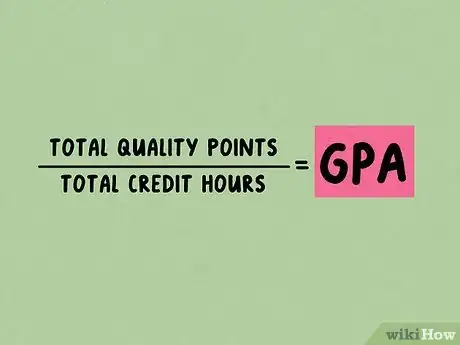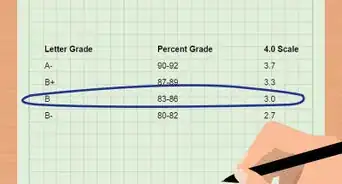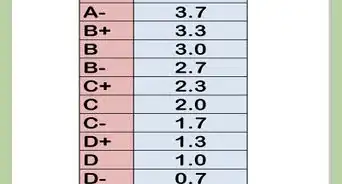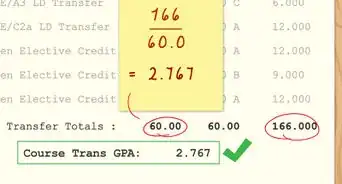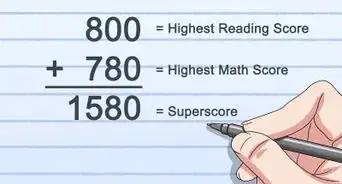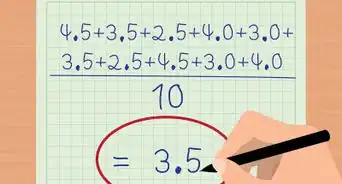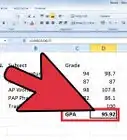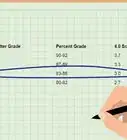This article was co-authored by wikiHow staff writer, Hannah Madden. Hannah Madden is a writer, editor, and artist currently living in Portland, Oregon. In 2018, she graduated from Portland State University with a B.S. in Environmental Studies. Hannah enjoys writing articles about conservation, sustainability, and eco-friendly products. When she isn’t writing, you can find Hannah working on hand embroidery projects and listening to music.
This article has been viewed 1,964,107 times.
Learn more...
It can be a bit tricky to and convert a grade or a group of grades in the form of a percentages into a 4.0 GPA. Here are some simple methods to clarify how a percentage may be accurately converted into a GPA, based on a 4.0 scale.
Steps
Conversion Help
Converting One Percentage into a 4.0 GPA
-
1Know the formula for converting a percentage into a 4.0 GPA. Let's use x to represent the percentage. The formula to use when converting a percentage into a GPA (with a scale of 4.0) is (x/20) - 1 = GPA.
-
2Plug the percentage into the formula and solve. Let's say you have an 89% in Geology. Just plug it into the formula to get the following:
- 89/20 - 1 =
- 4.45 - 1 = 3.45.
- The GPA equivalent of 89% is 3.45.
Advertisement -
3Use the same formula if the percentage is higher than 100%. The process will be the same even if your percentage is higher than 100%. Let's say you got a whopping 108% in Algebra. Here's what happens when you plug it in:
- 108/20 - 1 =
- 5.4 - 1 = 4.4
- The GPA equivalent of 108% is 4.4.
-
4Consider using a scale instead. This may be useful depending on what you are calculating your GPA for. If you are calculating one grade at a time to see how they will add up for your high school GPA, then you may not have to follow this exact formula because all grades will fall within a range anyway. For example, if your grade falls within the range of 83-86, then depending on your high school, then you will have a B, or a 3.0, whether it falls on the higher or lower part of the range or not.
- Check out your school's GPA system to figure out how to do this; some high schools have a slightly different range for what makes an A- vs. an A, a B vs. a B+, and so on.
Converting Multiple Grades into a 4.0 GPA
-
1Assign a numerical score to your each of your grades. Each grade that you get at the end of a class has a number equivalent on the 4.0 scale. Find a number equivalent for each grade that you get. Each school's numeral scores may vary slightly, so look into the GPA system at your school. Here is what the typical scoring system looks like:
- A = 4
- A- = 3.7
- B+ = 3.3
- B = 3
- B- = 2.7
- C+ = 2.3
- C = 2.0
- C- = 1.7
- D+ = 1.3
- D = 1
- D- = .7
- F = 0
-
2Add up all of your numerical scores. Add up the numerical scores assigned to each of your grades. For the sake of example, say you took English (C+), History (B), Math (B+), Chemistry (C+), Physical Education (A-), and Art (A-). That would mean you'd have: 2.3 + 3 + 3.3 + 2.3 + 3.7 + 3.7 = 18.3.[1]
-
3Divide your number by the number of classes you took. This is another way of saying that you will have to find the average numerical score. This will give you your final GPA score on a 4.0 scale.[2]
- In our example, we added up our numbers to get 18.3. Since we took six classes, we have to divide 18.3 by six. 18.3 ÷ 6 = 3.05 (or 3.1).
Calculating Weighted GPA
-
1Understand weighted GPA. Weighted GPA is the idea that some harder classes, like honors or AP, should be weighted to reflect an extra degree of difficulty. So, instead of the traditional 4.0 grade scale, a weighted scale can go as high as 5.0, reflecting a harder course load. The idea is that getting a "C" in AP Algebra is just as hard as getting a "B" in regular Algebra.
-
2Assign a numerical score to each of your grades. This time, use the same table as above, except add 1 point to each grade that you got in an honors or AP class.[3] Here is what the scaling system usually looks like:
- A = 5
- A- = 4.7
- B+ = 4.3
- B = 4
- B- = 3.7
- C+ = 3.3
- C = 3.0
- C- = 2.7
- D+ = 2.3
- D = 2
- D- = 1.7
- F = 1
-
3Add up all your numerical scores. Add up the numerical scores assigned to each of your grades. For the sake of example, say you took AP English (C), Honors History (B), Math (B), AP Chemistry (C+), Music Theory (B-), and Honors Art (A-). That would mean you'd have: 3 + 4 + 3 + 3.3 + 2.7 + 4.7 = 20.7.
-
4Divide your number by the number of classes you took. Again, you're just finding the average score. This will give you your final GPA score on a 5.0 scale. Note that you can only receive a 5.0 GPA if all of your classes are honors or AP and you receive an "A" in each class. Many students are required to take classes without extra degrees of difficulty, such as gym.
- In our example, we added up our numbers to get 20.7. Since we took six classes, we have to divide 20.7 by six. 20.7 ÷ 6 = 3.45 (or 3.5).
Calculating transcript or research only courses
For those with only a B.Sc. Transcript or Research M.Sc. (no courses taken), use this method.
-
1Multiply the course Credit Hours by the letter grade equivalent (see below) to get the Quality Points.
- For example: (3 Credit Hours * 4.5 (A+))
-
2Total the credit hours in your last 2 years of study or in the last 60 Credit Hours (see above).
-
3Divide the total Quality Points by the total Credit Hours.
- Product: Credit Hours * letter grades)) / (Total Credit Hours); or
- (Quality Points) / (Total Credit Hours)
-
4Finished. This is your GPA.
- Calculated GPA /4.0 = X / 4.5
Our Most Loved Articles & Quizzes
Community Q&A
-
QuestionHow can I convert a 98 weighted grade point average to the 4 point scale?
 Community AnswerThis depends on what class you are taking. Most schools have all grades above 90+ count as a 4.0. However, AP classes usually have a weight of 5.0, and some schools weigh harder classes differently. You should figure out how your school weighs their GPAs and calculate your GPA accordingly.
Community AnswerThis depends on what class you are taking. Most schools have all grades above 90+ count as a 4.0. However, AP classes usually have a weight of 5.0, and some schools weigh harder classes differently. You should figure out how your school weighs their GPAs and calculate your GPA accordingly. -
QuestionHow can I convert a score of 11.54/20 into a GPA?
 Community AnswerThe best way to estimate GPA is by using a calculator. First divide 11.54/20 and multiply by 100 to get the percentage, which would be 57.7%. Then divide 57.7 by 20, which is 2.885. Now subtract 1 from 2.885, which is 1.885 (5-point system) or 0.885 (4-point system) (D-).
Community AnswerThe best way to estimate GPA is by using a calculator. First divide 11.54/20 and multiply by 100 to get the percentage, which would be 57.7%. Then divide 57.7 by 20, which is 2.885. Now subtract 1 from 2.885, which is 1.885 (5-point system) or 0.885 (4-point system) (D-). -
QuestionIf I got a 3.6 GPA out of 4, how can I convert it into percentage?
 DonaganTop AnswererIf 4 is 100%, 3.6 is 90% (3.6 ÷ 4 = 0.9).
DonaganTop AnswererIf 4 is 100%, 3.6 is 90% (3.6 ÷ 4 = 0.9).
References
About This Article
To convert a percentage into a 4.0 grade point average, start by dividing the percentage by 20. Then, just subtract 1 from that number to get the grade point average. For example, if your grade is 89 percent, you would start by dividing 89 by 20, which would give you 4.45. Then, you would subtract 1 from 4.45 and get 3.45, which would be your grade point average. To learn how to convert multiple percentages into a 4.0 grade point average, scroll down!
